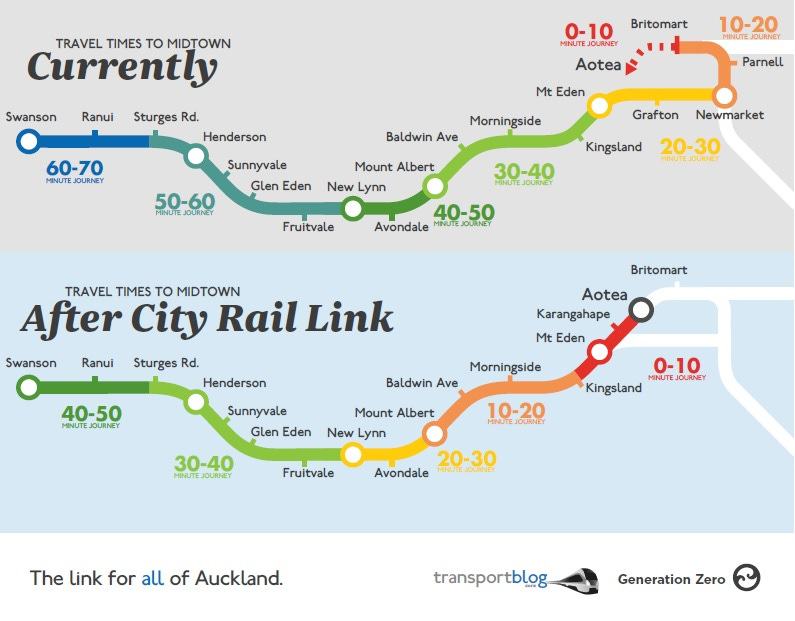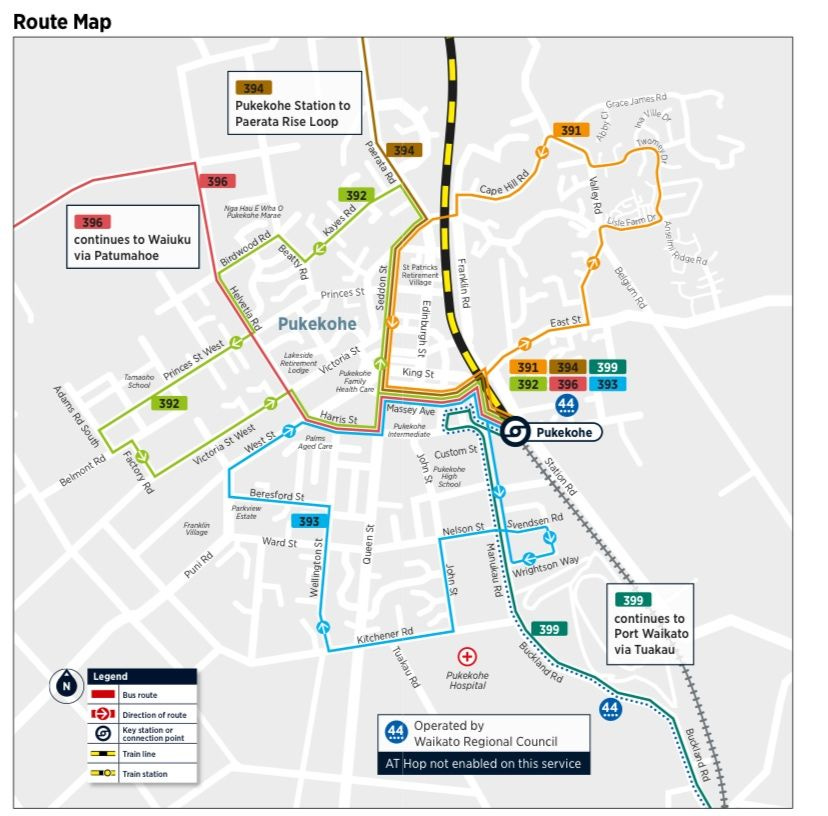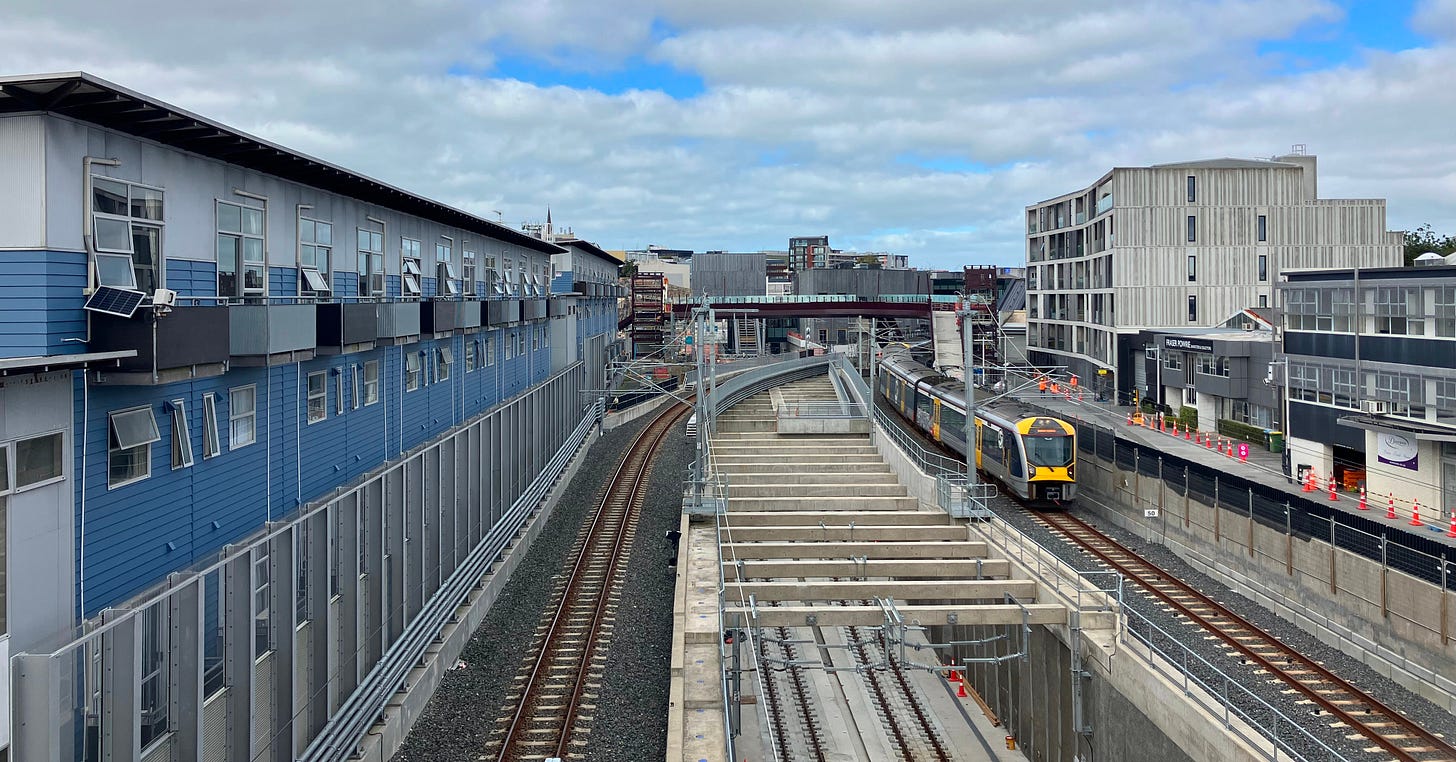New Zealand’s largest infrastructure project, the City Rail Link (CRL), is expected to open in 2026. This will be an exciting step forward for Auckland, delivering better access to the City Centre, increased network capacity and more frequent trains across the network.
However, this is not the endpoint. There are several steps we need to take to maximise the value of our investment in the CRL. Speaking broadly, these are:
Unlocking more capacity in the rail network by removing network constraints, so that we can run more trains, more often.
Station access: Making it easier to access our train stations
Land-use changes: enabling more homes and jobs around train stations.
Through these actions, we can:
Maximise the number of trains we can operate at peak times (and throughout the day) to deliver high capacity.
Maximise the number of people able to use this capacity to achieve higher patronage.
These are not chronological steps, rather they go hand in hand and create positive feedback loops. More frequent trains reduce journey times (when you account for wait time), making public transport more useable and further driving patronage to support more investment. Maximising the number of people who can access your existing services will still deliver benefits, with higher patronage and a better financially performing network, before additional capacity is required.
In the rest of this article, I will unpack at a high level what these steps look like.
Unlocking more capacity from the network
The CRL removes the current main bottleneck on our rail network, which is Britomart station. By through-running trains, we will be able to go from 20 trains per hour into the City Centre, up to 30 trains per hour (15 in each direction). But other constraints on the network limit us from fully utilising the new tunnel, which should be able to get up to 48 trains per hour. So how can we unlock the rest of this capacity?
If you are struggling to translate what that means, 48 trains per hour (24 in each direction) is one every 2.5 minutes. Proper metro frequencies and something to aspire to!
Removal of level crossings, where roads cross the rail tracks, will allow us to run more trains, more often with no disruption to the road network. Plans are in place to remove the final level crossings from the Southern Line (north of Papakura)1. The Eastern Line, thanks to it being built at a later date, is already level crossing free. The real challenge lies in addressing the Western Line, where there are 15 level crossings remaining. Most of which will require a grade-separation project to address. Without removing the level crossings, we will be unable to run more trains without major disruption to the road network, which of course is politically a non-starter.
We also need to add more tracks to boost capacity in the busiest sections of the network. Currently, the Third Main project is nearing completion2. This adds a third track between Westfield and Wiri, the busiest section of our network. This will enable some separation of express passenger services and freight trains from regular service. However, we need a fourth track, to unlock the full extent of service to South Auckland, including Drury and Pukekohe. This would allow trains from south of Manukau, to run an express pattern between Manukau and the city to deliver faster journeys from the south, while another pattern stops at all stations. However, the existing corridor remains a constraint to the Fourth Main Line being built. As is some of the existing infrastructure with some bridge spans being too narrow.

The other change is upgrading signalling to enable more trains to operate. Auckland’s rail network currently operates with the European Train Control System (ETCS) Level 1. Level 1 is a static tracking system, only allowing one train into a section of track at a time. The next step would be to ETCS Level 2, which provides continuous “supervision” of all trains on the tracks, knowing the location of each and communicating directly with each train3. This would safely allow closer operation and higher throughput on the lines. Level 2 becomes a requirement at around 18-20 trains per hour in each direction and therefore is key for moving towards 48 trains per hour through the CRL. However, it is less critical if we have not largely addressed level-crossing constraints first.
Much of this is spelt out in the Auckland Rail Programme Business Case, a joint Auckland Transport - KiwiRail business case. What is now needed, is a finalised investment plan for the next 10 years with agreed funding commitments, including the identified use of funding tools to help capture the benefits and help pay for upgrades. With this in place, we can get on with identifying solutions, purchasing land where required, identifying funding solutions and communicating with the public ahead of disruptions.
Enabling land use change (Transit Oriented Development)
Allowing more people to live and work close to our rail network will further maximise the value of City Rail Link. For this, we need changes to our planning rules, to enable higher density, mixed-use development in station catchments (minimum 800m). This was a key part of the internationally lauded National Policy Statement on Urban Development (NPS-UD). However, in Auckland, we still have yet to see the upzoning around train stations implemented.
Housing (and now Transport) Minister Chris Bishop has signalled that Auckland Council (and other Tier One authorities) will be required to enable greater density and mixed-use development, building on the NPS-UD4. The timing of this implementation is still unknown but the closer these changes are delivered to the City Rail Link opening in 2026, the sooner we can get on with building more homes and jobs around the rail network.
The CRL will dramatically improve public transport access in the inner west suburbs of Kingsland, Morningside and Mount Albert. These will be some of the most accessible neighbourhoods in the city by public transport post-CRL, which will deliver a 50-72% time saving by train to the middle of the City Centre5.

However, large parts of these areas are under special character protection, meaning that more homes cannot be built. This has led to the Infrastructure Commission referring to these areas as Transit Oriented Museums6. It is critical to maximise the value of CRL that we change this to enable more homes to be built along the inner-Western Line.
Improving station access
The third step to maximise the value of the CRL and support patronage growth is to make it easier to access stations across the network. This means investing in walking, cycling and public transport access, which can maximise the rail users in a spatially efficient manner.
Park and Rides have a role in some locations, typically at the city fringe, but are a spatially inefficient and costly way to increase patronage7. So, what do we need to focus on instead?
Additional station entrances can provide more direct access and increase the walking catchments of stations. Glen Eden provides a good example where an entrance at the Eastern end of the station would provide a 150m saving each way and increase the number of properties within the 800m of the station substantially8. This would also increase the number of properties upzoned under the NPS-UD to enable more homes.

Investing in feeder bus routes and supporting infrastructure is critical to maximising the catchment of the station to improve public transport access for suburbs further out. A great example of this was with the reopening of Pukekohe Station, following the completion of electrification, which saw all local feeder buses upgraded to a 20-minute frequency9. This goes hand in hand with the upgraded 6-bay bus interchange that opened in 2018.

Improving walking and cycling infrastructure within the catchment. This means improving footpaths, building cycleways and addressing missing crossings. In 2022, Auckland Transport with AECOM, developed the Auckland Rapid Transit Study, which evaluated every existing and planned station against a standard developed based on the category of station10. This provides a strong basis for where and what scale of improvements are needed by each access mode, at each station.
Most station access interventions have quite localised benefits. This provides the opportunity to consider the use of targeted rates for a portion of the funding, acting as a proxy for value capture.
Final thoughts
This article has sought to outline, at a high level, what we need to do to maximise the value of the investment in the City Rail Link. There is of course far greater complexity in each of the points discussed. However, it is important to bring these together and consider how each contributes to the overarching goal of maximising the value from the (joint local and central government) investment in the CRL.
Supporting Growth (2024). Level Crossings in Takaanini. https://findoutmore-supportinggrowth.nz/level-crossings-in-takaanini
Kiwirail (2024). The Third Main Line. https://www.kiwirail.co.nz/our-network/our-regions/amp/the-third-main-line/
European Commission. ETCS Levels and Modes. https://transport.ec.europa.eu/transport-modes/rail/ertms/what-ertms-and-how-does-it-work/etcs-levels-and-modes_en
Christopher Bishop (2024). Going for Housing Growth speech. Beehive. https://www.beehive.govt.nz/speech/going-housing-growth-speech
Matt Lowrie (2014). How the CRL transforms travel in the West. Greater Auckland. https://www.greaterauckland.org.nz/2014/11/14/how-crl-transforms-travel-in-the-west/
Oliver Lewis (2024). The city rail link and ‘transit-orientated museums’. BusinessDesk. https://businessdesk.co.nz/article/infrastructure/the-city-rail-link-and-transit-orientated-museums
Jarret Walker (2014). Basics: The Math of Park-and-Ride. https://humantransit.org/basics-the-math-of-park-and-ride
Malcolm McCracken (2021). Improving walkability to rapid transit. Transportation Group Conference 2021. https://airdrive.eventsair.com/eventsairaueprod/production-harding-public/4531ad0ac5784fb0b9a821265765a918
Pete Moth. LinkedIn. https://www.linkedin.com/posts/peter-moth-abb49457_great-news-for-pukekohe-today-train-services-activity-7291913863497756672-EqFi/
Auckland Transport & AECOM. Auckland Rapid Transit Station Study. https://at.govt.nz/about-us/reports-publications/auckland-rapid-transit-station-study






The fourth main will be essential for any long term inter-regional services, so they can run express through the Auckland metro area. That and electrification to Te Rapa can’t come soon enough!
The CRL would also have cascading effects along the rest of the network, so I think the service patterns AT ends up should have that in mind. Main example I can think of is a line running between Newmarket and Panmure, which would give the 70 more capacity along the Ellerslie-Panmure Highway. Since there's also the plan to extend the Eastern Busway thru it, u could upzone around the entirety of highway to get more people along it onto the 70, which further makes the case for the extension.